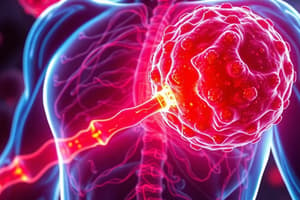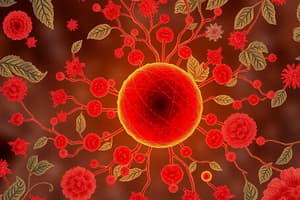Podcast
Questions and Answers
Which of the following are irritants that can cause inflammation?
Which of the following are irritants that can cause inflammation?
- Bacteria
- Chemical agents
- Mechanical injuries
- All of the above (correct)
What suffix is added to the name of an inflamed organ or tissue?
What suffix is added to the name of an inflamed organ or tissue?
itis
What is a characteristic of acute inflammation?
What is a characteristic of acute inflammation?
- Short duration (correct)
- Prolonged exposure
- Slow response
- Accumulation of lymphocytes
Which cells are primarily involved in the acute inflammatory response?
Which cells are primarily involved in the acute inflammatory response?
What is the first phase of phagocytosis?
What is the first phase of phagocytosis?
Chronic inflammation can start from the beginning without an acute phase.
Chronic inflammation can start from the beginning without an acute phase.
The four cardinal signs of acute inflammation are redness, hotness, swelling, and ______.
The four cardinal signs of acute inflammation are redness, hotness, swelling, and ______.
What process do leukocytes undergo to exit blood vessels during inflammation?
What process do leukocytes undergo to exit blood vessels during inflammation?
What can be a fate of acute inflammation?
What can be a fate of acute inflammation?
What is leuocytosis?
What is leuocytosis?
Which type of inflammation is characterized by the formation of pus?
Which type of inflammation is characterized by the formation of pus?
Study Notes
Inflammation: Local defense and protective response
- Inflammation is a localized response to cell injury or irritation.
- It involves vascular, cellular, and lymphatic reactions against an irritant.
Irritating or injurious agents (Irritants)
- Living irritants include bacteria, fungi, viruses, parasites, and their toxins.
- Non-living irritants include chemicals, physical agents, mechanical forces, and hypersensitivity reactions.
Types of inflammation
- Acute inflammation: Rapid onset, short duration (minutes to days), characterized by fluid, plasma proteins, and neutrophils (PNL) in the tissue.
- Subacute inflammation: Rarely occurs, intermediate between acute and chronic.
- Chronic inflammation: Slow onset, longer duration (days to months), characterized by lymphocytes, plasma cells, macrophages, and fibroblasts in the tissue.
Cells of inflammatory response
- Polymorphonuclear leukocytes (PMNs): Neutrophils, which become pus cells when they die.
- Monocytes or histocytes: Macrophages.
- Giant cells: Formed by the fusion of macrophages.
- Lymphocytes: B and T lymphocytes.
- Plasma cells: Developed from activated B cells.
- Eosinophils: Involved in allergic and parasitic infections.
- Fibroblasts: Involved in tissue repair.
Pathogenesis of acute inflammation
- Local destruction of tissue: Necrosis in the area of maximal irritant concentration, leading to the release of chemical mediators like histamine.
- Local vascular changes:
- Initial temporary vasoconstriction for a few seconds.
- Active vasodilatation of arterioles and capillaries (induced by histamine) and passive dilatation of venules.
- Increased capillary permeability (fluid exudate to the extravascular tissue), resulting in blood cell concentration and slowed blood flow (stasis).
- Pavementing and margination of leukocytes.
- Emigration of leukocytes, fluid, and plasma proteins outside the blood vessels into the surrounding tissue (forming inflammatory fluid exudate).
- In some cases, red blood cells may also pass through (Diapedesis).
- Dilatation of lymphatic vessels to accelerate lymph flow and drain fluid exudate.
- Reaction of tissue histiocytes: Proliferation of tissue histocytes (normally present in connective tissue and organs) to phagocytose remaining bacteria, cellular debris, and fibrin.
What do neutrophils do?
- Phagocytosis: neutrophils engulf and destroy microbes.
- Steps of phagocytosis include recognition, ingestion, vacuole formation, digestion, and exocytosis.
- Opsonins, like Fc and C3b receptors, aid in recognizing and binding microbes.
Macroscopic signs of acute inflammation (Cardinal signs)
- Redness: Caused by increased blood flow.
- Hotness: Caused by increased blood flow.
- Swelling: Caused by fluid exudate accumulating in the tissue.
- Pain and tenderness: Caused by pressure on nerve endings by the swelling and by chemical mediators.
- Loss of function: Caused by pain and swelling.
General effects of acute inflammation
- Fever: Caused by release of pyrogenic compounds and increased tissue metabolism.
- Leucocytosis: Increase in white blood cell count above 10,000/cm3, caused by the liberation of leucocytosis promoting factor from injured tissue.
- Toxic effects: Anorexia, headache, etc.
Fate of acute inflammation
- Resolution: Exudates are reabsorbed and the tissue returns to normal.
- Healing: By repair and regeneration.
- Progression and Spread: Through lymphatics or the bloodstream.
- Chronicity: Occurs when the causative agent is partially overcome.
Types of acute inflammation (based on type of exudates)
- Suppurative or purulent inflammation: Characterized by pus formation (pus cells, neutrophils, and other debris).
- Localized: Abscesses (walled-off collections of pus)
- Diffuse: Cellulitis (widespread inflammation of subcutaneous tissue)
- Non-suppurative inflammation:
- Catarrhal inflammation: Characterized by mucus production.
- Serous inflammation: Characterized by thin, watery fluid exudate.
- Fibrinous inflammation: Characterized by a fibrinous exudate (thick, sticky fluid).
- Membranous inflammation: Characterized by a membrane-like exudate (fibrin and inflammatory cells).
- Hemorrhagic inflammation: Characterized by bloody exudate.
Chronic inflammation
- May follow acute inflammation or begin chronically.
- Results from increased resistance of the causative agent to phagocytosis or a depressed immune response.
- Shows lower vascular and exudative responses compared to acute inflammation.
- Characterized by an accumulation of lymphocytes, plasma cells, macrophages, and fibroblasts.
Chronic inflammation (Granulomatous)
- Characterized by the formation of granulomas.
- Granulomas are specialized inflammatory structures that form when the body is unable to eliminate a foreign agent.
- Common causes include tuberculosis, leprosy, and fungal infections.
Studying That Suits You
Use AI to generate personalized quizzes and flashcards to suit your learning preferences.
Related Documents
Description
Explore the intricate processes involved in inflammation, our body's local defense mechanism against injury and irritation. This quiz covers types of inflammation, irritating agents, and the role of various cells in the inflammatory response. Understand the distinctions between acute, subacute, and chronic inflammation.





